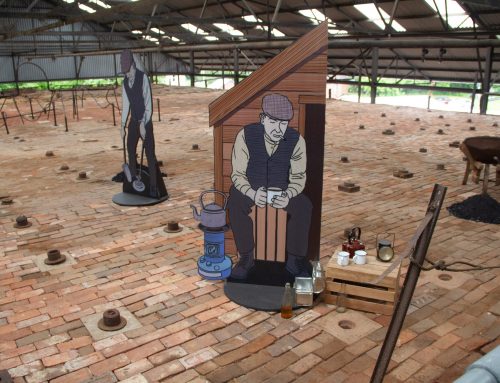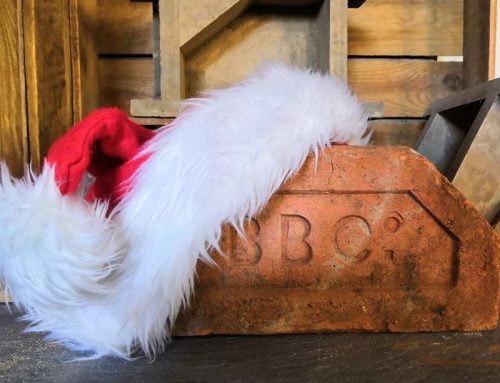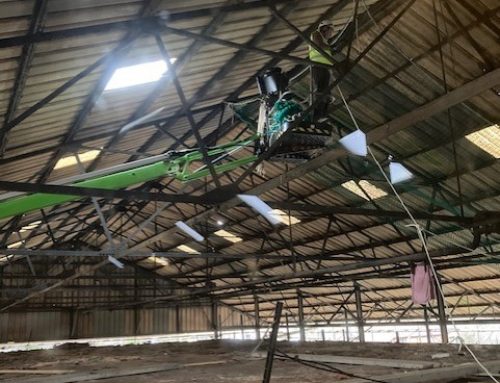This fascinating article appeared in Brickbats – the magazine sent to all of our volunteers and annual members – in August. It charts the very first 50 years (before the factory was even founded!) of the Brickworks.
Want more fascinating articles about brick based matters (of course you do)? Sign up to our annual membership scheme today.
This year, 2022, marks the 125th anniversary of the opening of the Hopper and Ashby brickworks in Swanwick, which, in 1903 became Bursledon Brick Works. But the origin of the works can be traced back much further and in a series of steps of one decade each I will count down (or up) to 1897, tracing how brick manufacture became an important part of Hooper and Ashby’s business.
1847

The decade began with Edward Hooper, a 24 year old Civil Engineer establishing himself in the town of Southampton. In March 1850 The Exbury White Brick and Tile Works was up for sale and I think it likely that it was purchased by Edward. Five months later he was advertising the availability of bricks from Exbury, with samples on view at his office in Southampton High Street. By 1851 he employed 11 men and was involved in brick and drainpipe manufacture. He moved his office to Portland Street, later the offices of Hooper and Ashby would be located nearby, but at this time there were no members of the Ashby family on the scene. In March 1856 Edward took out a lease on Baltic Wharf, in the busy docks on the western bank of the River Itchen.
Pictured above – Trees cover the area where the Exbury brickworks made white bricks which would have been taken by sailing boats to the yard in Southampton.
1857

In 1859 Edward began renting the neighbouring premises, American Wharf, where he established a builder’s merchants business advertising, among other products, white facing bricks which were probably from the brickyard at Exbury, although we know he also ordered bricks from Bailey’s Hard Brickyard, Beaulieu.
In the summer of 1860 Edward married Harriet Ashby. The 1861 census shows that they already had two daughters aged 5 and 3 and that Edward now employed 24 men in his business, and for his household, 3 servants.
Around 1862, Harriet’s brother, 21 year old Edmund Ashby, moved from Staines to Southampton.
On the 29th of April 1863 Harriet gave birth to a still born child. She died on the same day, aged 31.
Around a year later the name of Edward Hooper and Edmund Ashby entered into partnership and at about the same time, Edward’s brother, Charles Hooper, a retired surgeon, took up residence in Hythe, Hampshire. Why Hythe? It was probably to oversee the brickyard at Lower Exbury, a few miles away.
Pictured above – Edward Hooper began renting this warehouse and wharf in 1859, and for many years following, American Wharf became the headquarters of Hooper & Ashby.
1867
On the 2nd of July 1869, Edward Hooper died, aged just 46. Shortly afterwards, his brother Charles created a separate company, Charles Hooper & Co., to encompass the Exbury White Brickworks. In the 1871 census, Charles described himself as a medical doctor with a share in a brick business. In fact he was just a part of Hooper & Ashby, and operated from an office in American Wharf. Many large businesses were s
plit into smaller parts which probably had financial benefits, to do with taxation. Nevertheless, it is the reason why many of the early bricks made by Hooper & Ashby were stamped “H & Co.”
1877

Around 1879 Edmund Ashby signed a lease for 6 acres of land at Chandlers Ford, between Southampton and Winchester, next to the main railway line between Portsmouth and Salisbury. This was for digging clay and making bricks. These red bricks were available for sale by 1881.
Edmund was joined in the business by his brother Robert, who brought with him money ready to invest in the new venture in Chandlers Ford. It was decided to mass produce bricks using a Bennett and Sayer machine, which combined a clay treatment plant with an extruder for making wire-cut bricks. They employed the services of the experienced brickmaker, Samuel Batley, who moved down from Yorkshire to become their manager.
In 1879 Charles Hooper retired from the business and that ended the Hooper connection. From now on it would be only Ashbys, and the Ashbys were a big family.
Pictured right – Edward Hooper had an office here at 2, Portland Street in central Southampton.
1887
The Chandlers Ford Brickworks was a great success, but it used up clay so quickly that the material was becoming exhausted, despite expansion of the clay pits. Eventually a completely new location was found, on the banks of the River Hamble at Lower Swanwick.
In 1896 Charles Hooper died.
1897

The new works were built and opened 125 years ago. Chandlers Ford was gradually closed and several of the employees moved, with their families, to Lower Swanwick. One of the last to move was Samuel Batley, in 1902. The machinery from Chandlers Ford was almost certainly moved to Swanwick when the Northern Works was built in 1903 and in the same year The Bursledon Brick Company was formed, and the pressed bricks began to be stamped with the initials, “BBC”.
Pictured right – This advert from 1903 explains how the Hooper & Co. name will disappear, and will be replaced by The Bursledon Brick Company.
POST SCRIPT
2023 will mark the 200th anniversary of Edward Hooper’s birth. Next year, you may like to celebrate the bi-centenary by joining me in raising a glass to the man who started it all. Surely, he could not have imagined that one day his name would be remembered, in a Brickbats article.
Written by museum researcher and volunteer Jim Beckett in 2022.











FOLLOW US